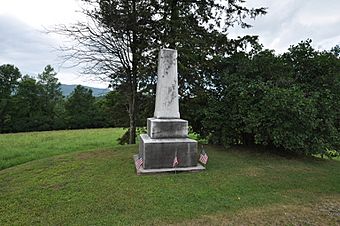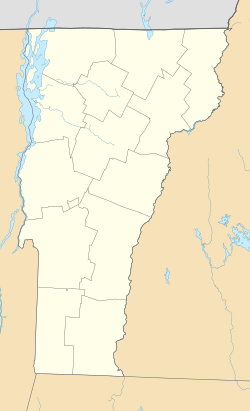Fort Vengeance Monument Site facts for kids
Quick facts for kids |
|
|
Fort Vengeance Monument Site
|
|
 |
|
| Location | US 7, 0.57 mi. S of town line, Pittsford, Vermont |
|---|---|
| Area | 2 acres (0.81 ha) |
| Built | 1774 |
| NRHP reference No. | 06000139 |
| Added to NRHP | March 15, 2006 |
The Fort Vengeance Monument Site is a special place in northern Pittsford, Vermont. It's located right on United States Route 7. This site holds the hidden remains of one of Vermont's oldest homes. It's also the only known spot where a military fort from the American Revolutionary War once stood. A stone monument was placed here in 1873 to remember the fort. The site was officially added to the National Register of Historic Places in 2006.
What is Fort Vengeance?
Fort Vengeance is an important historical site in Vermont. It shows us where people lived and fought during the American Revolution. The site is marked by a marble stone next to a pullout on US 7. It covers about 2 acres of land. Part of the modern road might even be built over some of the old fort.
Why Was Fort Vengeance Built?
During the American Revolution, in 1777, British General John Burgoyne led a large army. He came south from Montreal to attack forts like Fort Ticonderoga. His goal was to meet other British forces and split the American colonies in half. The British also used Native American allies to raid towns and farms. These raids involved burning homes and taking settlers captive.
Because of these attacks, Fort Vengeance was built in early 1780. Its purpose was to protect the local area. Major Ebenezer Allen was put in charge of the fort. He had 150 soldiers under his command. One soldier, Caleb Houghton, was found shot and wounded near the fort. After this event, Major Allen named the new fort "Fort Vengeance."
What Was Found at the Site?
The Fort Vengeance site holds the archaeological remains of two old houses. The oldest house belonged to Caleb Hendee. He moved to the area and built his home in 1774. When the site was listed as historic, it was the oldest known farmstead in Vermont.
In 1780, Hendee's farm became the location for Fort Vengeance. This fort was built with strong walls, called a palisade. The independent government of the Vermont Republic ordered its construction. It was part of their defense line in the north. The fort had barracks for soldiers and a place to store gunpowder. It was used until 1782. Fort Vengeance was one of three forts ordered in the Pittsford-Brandon area. It is the only one whose exact location is known and can be studied by archaeologists.
Caleb Hendee's house was likely left empty around the mid-1800s. His son, Samuel, probably built a new house further south. He might have even torn down the old house and fort remains. Later, in 1860, another house was built on the site by Chester Thomas. This second house was taken down around 1900.
See also
 In Spanish: Sitio del monumento de Fort Vengeance para niños
In Spanish: Sitio del monumento de Fort Vengeance para niños



